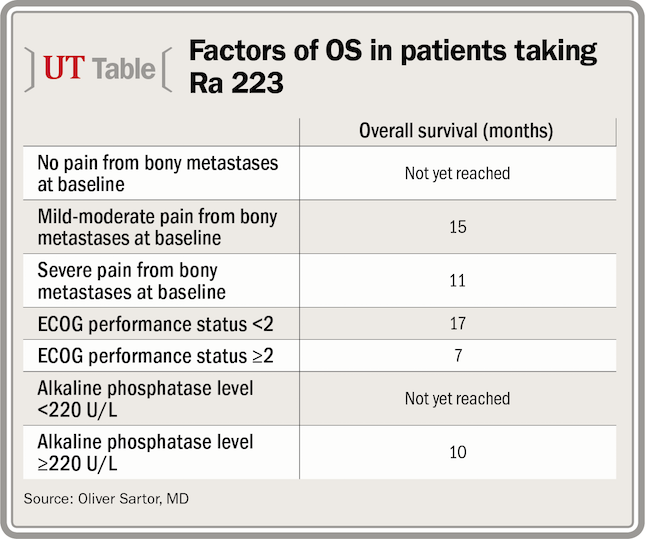Article
Prognostic factors identified in patients taking PCa Tx
Analyses of overall survival rates among subgroups of men who received radium-223 dichloride (Ra 223; Xofigo) as part of an expanded access program suggest factors that may have prognostic significance, including effects of prior and concomitant treatments.
New Orleans-Analyses of overall survival rates among subgroups of men who received radium-223 dichloride (Ra 223; Xofigo) as part of an expanded access program (EAP) suggest factors that may have prognostic significance, including effects of prior and concomitant treatments.
Read: A new castration-resistant prostate cancer entity?

Dr. SartorFurther study is needed, however, to confirm these preliminary findings, according to Oliver Sartor, MD.
“Taken together, the EAP data indicate the safety and tolerability of Ra 223 outside of the randomized phase III trial setting. Further, these data raise the hypothesis that combining Ra 223 with newer agents such as denosumab [XGEVA], abiraterone [ZYTIGA], and/or enzalutamide [XTANDI] may be preferable to sequential approaches,” said Dr. Sartor, Laborde Professor of Cancer Research, departments of medicine and urology, Tulane School of Medicine, New Orleans.
Dr. Sartor was an investigator in ALSYMPCA, the pivotal trial of Ra 223, and treated men in the EAP. The research was presented at the 2015 American Society of Clinical Oncology annual meeting in Chicago.
The EAP gave men in the United States and other countries the opportunity to receive Ra 223 for treatment of metastatic castration-resistant prostate cancer (mCRPC) prior to regulatory approval of the alpha-emitting radiopharmaceutical. Men were eligible if they had bony metastases without visceral metastases or lymph node metastases >3 cm. As in the pivotal ALSYMPCA trial, men in the U.S. EAP had to have symptoms from their skeletal metastases, whereas asymptomatic men could receive Ra 223 treatment in the international EAP.
Analyses of data from 184 patients enrolled in the U.S. EAP focused on the effects of prior treatment with abiraterone acetate and enzalutamide and the prognostic significance of number of Ra 223 injections. According to the prescribing information, Ra 223 should be administered as six monthly injections.
Next: Less pretreatment linked to more injections
Less pretreatment linked to more injections
The results showed a trend for men who were less heavily pretreated to receive more injections, and a multivariate analysis found prior treatment with both abiraterone and enzalutamide as well as ECOG performance status ≥2 and decreased baseline hemoglobin were independent predictors for men to receive fewer than five versus five or six injections.
Also see: How the economy predicts PCa diagnosis, management
Looking at the prognostic significance of number of Ra 223 injections received, there was a trend for longer median overall survival with receipt of five or six versus fewer injections (not yet reached vs. 7.5 months).

Discussing the findings with Urology Times, Dr. Sartor said, “The analyses from the U.S. EAP indicate that men who received fewer than the six recommended injections of Ra 223 likely had more advanced disease with a worse prognosis, and that may be a confounding factor in determining the prognostic significance of the number of injections.”
Recommended: PCa castration study fuels surgery vs. GnRHA debate
He continued, “Still, there may be a message here for physicians who are deciding on whether a man is a candidate for Ra 223 to consider whether the patient is likely to receive at least five injections. The findings also raise the question of whether the current paradigm that positions administration of Ra 223 later in the treatment sequence for men with mCRPC may significantly limit the number of patients able to receive the recommended six injections.”
Next: Concomitant therapy prolongs survival
Concomitant therapy prolongs survival
The international EAP analyses also looked at the effects of concomitant treatments that were not used by men during ALSYMPCA. The results showed that men who were on denosumab or abiraterone with Ra 223 benefited with significant prolongation of overall survival. Median overall survival was 13 months among men not on concomitant denosumab and 14 months among men not on concomitant abiraterone, but was not yet reached among men being treated concomitantly with either denosumab or abiraterone.
“These differences were statistically different, implying that combination therapy was more effective,” Dr. Sartor said.
Twenty-two percent of men in the cohort were on concomitant abiraterone and almost the same proportion were on concomitant denosumab.
Dr. Sartor noted that while there were no theoretical concerns about combining Ra 223 with abiraterone, it is reassuring to have confirmatory data from the EAP programs. He said the benefit associated with concomitant denosumab treatment for improving overall survival is a little surprising considering that denosumab did not prolong overall survival in the phase III study in men with mCRPC.
“This information needs to be considered carefully considering the EAP is not a randomized, controlled trial. The data, however, certainly do not argue against using denosumab with Ra 223,” Dr. Sartor said.
The findings on the benefits of concomitant use of either abiraterone or denosumab with Ra 223 warrant further investigation of these combinations in clinical trials. The financial implications of combination therapy have yet to be explored, but when these studies are performed the comparison should be between combination and sequential approaches.
Safety analyses from the U.S. EAP showed Ra 223 was similarly safe and well tolerated regardless of prior treatment with abiraterone and/or enzalutamide. No new safety concerns emerged in the larger population of men included in the international EAP.
Dr. Sartor is a consultant to Bayer, Tokai, Janssen, Dendreon, Sanofi, Bellicum, Oncogenex, and Bavarian-Nordic and an investigator for Bayer, Tokai, Dendreon, and Janssen. Several of the study authors had a financial or other relationship with Bayer and/or other pharmaceutical companies.
More on Prostate Cancer
PCa tumor volume, grade on the rise post-USPSTF
Study: High surgeon volume linked to post-RP outcomes
Are you seeing a decline in PSA screening?
Subscribe to Urology Times to get monthly news from the leading news source for urologists.
Newsletter
Stay current with the latest urology news and practice-changing insights — sign up now for the essential updates every urologist needs.













